The global chocolate flavoring compounds market is valued at USD 40.7 billion in 2025 and is expected to reach USD 66.3 billion by 2035, reflecting a CAGR of 5.0%.
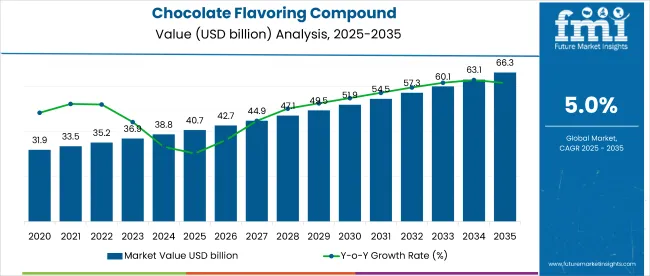
The growth in the market is largely driven by the increasing consumer preference for chocolate-flavored products, the rise of healthier alternatives, and the expansion of the confectionery sector. Rising consumer interest in organic and natural ingredients, along with innovations in low-sugar and fortified chocolate products, will continue to shape the market's evolution.
North America, particularly the USA, holds the largest share, growing at a significant CAGR of 5.7% from 2025 to 2035. Meanwhile, the UK and Germany are also witnessing robust growth with significant CAGRs of 6.3% and 6% respectively. By product type, milk chocolate accounts for a significant market share of 45%. Meanwhile, paste form holds a prominent share of 52% being a dominating segment in 2025.
The market holds varying shares across its parent markets. It accounts for around 10-15% of the global chocolate market, driven by the demand for flavored and compound chocolates. In the confectionery market, it holds an estimated 12-18% share, as chocolate is a key ingredient in many confectionery products.
The market contributes 8-12% to the beverage market, especially in chocolate-based drinks. In the dairy market, it represents about 5-7%, particularly in chocolate-flavored dairy items. The bakery market sees around 10-12% of its share, largely due to chocolate-flavored baked goods. In the snack market, the market holds roughly 6-8%, driven by chocolate-coated snacks.
Looking forward, the market is likely to benefit from recent innovations, including the development of healthier chocolate options, such as sugar-free and dairy-free compounds. With the increasing awareness of health and wellness, there is a growing demand for chocolate flavoring compounds that offer lower sugar content and enriched nutritional benefits. Government regulations supporting sustainable cocoa farming practices and eco-friendly packaging solutions are expected to further contribute to the market’s expansion.
The global market is segmented by product type, form, end use, and region. The product type, the market includes dark, milk, and white. In terms of form, the market is divided into solid and paste.
Based on end-use, the market is segmented into variegates, chocolate beverages, bakery, frozen desserts, confectionery, dairy, snacks, sauces & spreads, convenience food, and others (including niche food products). Regionally, the market is classified into North America, Latin America, Europe, the Middle East and Africa, East Asia, South Asia, and Oceania.
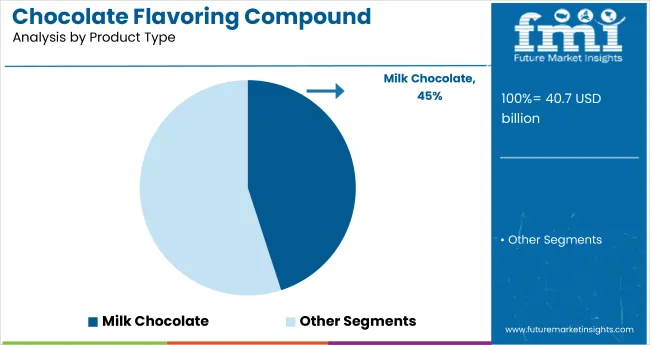
Milk chocolate remains the dominant segment, commanding the largest market share of 45% due to its widespread popularity across various consumer groups. It is a preferred choice in most confectionery products, including bars, coatings, and other chocolate-based snacks.
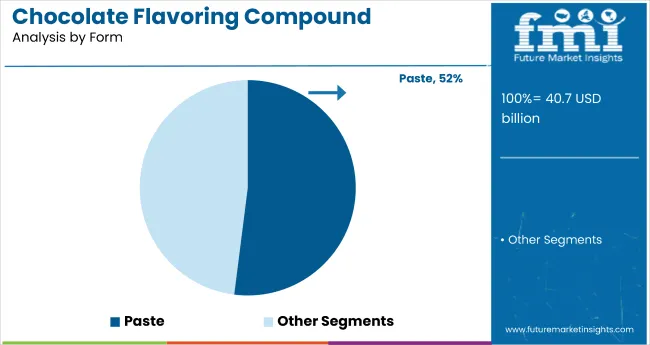
Paste chocolate is widely used in a variety of applications, including fillings, spreads, coatings, and confectionery bases. The segment accounts for 52% of the market share. Its smooth texture and versatility make it ideal for products like chocolate creams and fudge, where a semi-liquid consistency is required.
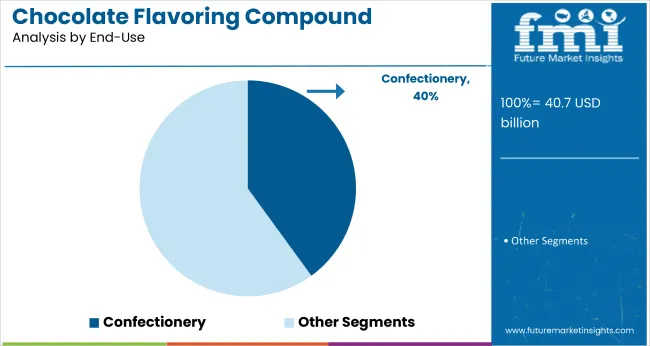
Confectionery continues to lead the end-use segment with 40% of the market share, driven by the global demand for chocolate-based sweets such as bars, truffles, and candies. This sector benefits from consistent consumer preferences for indulgent treats, especially in regions like North America and Europe.
The global chocolate flavoring compound market is witnessing sustained growth, fueled by rising demand for indulgent and innovative confectionery products. The surge in artisanal and premium chocolate trends, coupled with growing applications in bakery, dairy, and beverages, is driving market expansion.
Recent Trends in the Chocolate Flavoring Compound Market
Challenges in the Chocolate Flavoring Compound Market
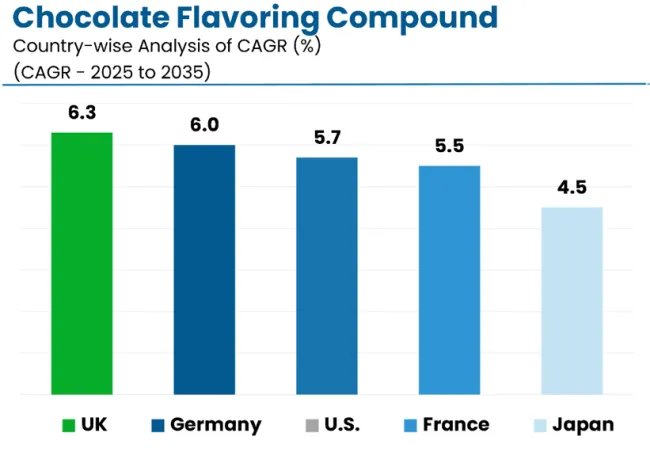
The market shows varied growth across key countries. The USA leads with a CAGR of 5.7%, driven by high demand for milk chocolate, specialty products, and healthier alternatives like sugar-free and organic varieties. The UK follows closely with a prominent CAGR of 6.3%, propelled by growing interest in premium, organic, and ethically sourced chocolates.
Germany and France exhibit similar growth at 6% and 5.5% CAGR, respectively, supported by a strong local demand for dark and milk chocolate, alongside the rise of functional, health-oriented products. Japan has the lowest growth rate at 4.5%, though it benefits from unique flavors and eco-conscious trends.
The report covers an in-depth analysis of 40+ countries; five top-performing OECD countries are highlighted below.

The revenue of chocolate flavoring compounds in the USA is projected to grow at a CAGR of 5.7% from 2025 to 2035. The USA remains the largest consumer and producer of chocolate, with strong demand for milk chocolate and specialty chocolate products. Market growth is driven by increasing consumer preference for healthier alternatives, including sugar-free and organic varieties.
The chocolate flavoring compounds market in the UK is projected to expand at a CAGR of 6.3% from 2025 to 2035. The country is witnessing a growing trend toward premium and organic chocolate, driven by rising consumer interest in healthier and more sustainable options.
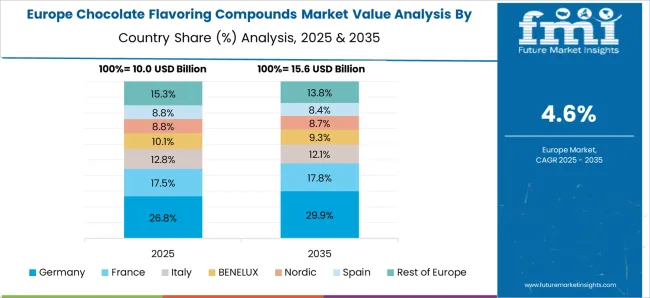
Sales of chocolate flavoring compounds in Germany are estimated to rise at a CAGR of 6% from 2025 to 2035. As one of the largest chocolate producers in Europe, Germany benefits from a strong presence of both domestic and international chocolate manufacturers.
Revenue from chocolate flavoring compounds in France is projected to grow at a CAGR of 5.5% from 2025 to 2035. The French chocolate market is driven by the country’s rich culinary tradition and a growing preference for premium and artisanal chocolate products.
The chocolate flavoring compounds market in Japan is anticipated to grow at a CAGR of 4.5% from 2025 to 2035. Japan is known for its innovative approach to chocolate, with strong demand for premium offerings and unique flavor innovations such as matcha-flavored and fruit-infused varieties.
The market is moderately fragmented, with several key global players competing for market share. Major suppliers such as Clover Hill Food Ingredients Ltd, Cargill, ADM WILD Europe GmbH & Co.KG, Nestlé, and Barry Callebaut are highly influential in this space.
These companies are vying for dominance through strategies that include innovation in chocolate formulations, strategic partnerships, expansion into emerging markets, and competitive pricing. Their focus on sustainability and clean-label products is also reshaping consumer demand, particularly in premium and organic chocolate segments.
Top companies in this sector continually invest in technological advancements to enhance their production processes and supply chains. Innovation in flavors, health-conscious formulations (like sugar-free and dairy-free options), and sustainable sourcing are pivotal to their market strategies.
Additionally, collaborations with retailers and online platforms to expand their distribution networks are key tactics for increasing market penetration. Competitive pricing remains a primary focus, especially in high-volume product lines, while maintaining product differentiation through unique offerings like functional and organic chocolate remains a strong point of competition.
Recent Chocolate Flavoring Compound Industry News
| Report Attributes | Details |
|---|---|
| Current Total Market Size (2025) | USD 40.7 billion |
| Projected Market Size (2035) | USD 66.3 billion |
| CAGR (2025 to 2035) | 5.0% |
| Base Year for Estimation | 2024 |
| Historical Period | 2020 to 2024 |
| Projections Period | 2025 to 2035 |
| Market Analysis Parameters | Revenue in USD billions/Volume in kilotons |
| By Product Type | Dark, Milk, and White |
| By Form | Solid and Paste |
| By End Use | Variegates, Chocolate Beverages, Bakery, Frozen Desserts, Confectionery, Dairy, Snacks, Sauces & Spreads, Convenience Food, and Others (including niche food products) |
| Regions Covered | North America, Latin America, Europe, Middle East & Africa, East Asia, South Asia, Oceania |
| Countries Covered | United States, Canada, United Kingdom, Germany, France, China, Japan, South Korea, Brazil, Australia add this 40+ countries in report scope |
| Key Players | Clover Hill Food Ingredients Ltd, Cargill, Incorporated, ADM WILD Europe GmbH & Co.KG, Nestlé, Wilmar International Limited, PURATOS, Shellz Overseas Pvt. Ltd., INFORUM Group, Buhler AG, Barry Callebaut, Unigrà S.r.l., Blommer Chocolate Company, CEMOI, HERZA Schokolade GmbH & Co. KG |
| Additional Attributes | Dollar sales by value, market share analysis by region, and country-wise analysis |
The global chocolate flavoring compounds market is estimated to be valued at USD 40.7 billion in 2025.
The market size for the chocolate flavoring compounds market is projected to reach USD 66.3 billion by 2035.
The chocolate flavoring compounds market is expected to grow at a 5.0% CAGR between 2025 and 2035.
The key product types in chocolate flavoring compounds market are dark, milk and white.
In terms of form, solid segment to command 56.8% share in the chocolate flavoring compounds market in 2025.






Our Research Products

The "Full Research Suite" delivers actionable market intel, deep dives on markets or technologies, so clients act faster, cut risk, and unlock growth.

The Leaderboard benchmarks and ranks top vendors, classifying them as Established Leaders, Leading Challengers, or Disruptors & Challengers.

Locates where complements amplify value and substitutes erode it, forecasting net impact by horizon

We deliver granular, decision-grade intel: market sizing, 5-year forecasts, pricing, adoption, usage, revenue, and operational KPIs—plus competitor tracking, regulation, and value chains—across 60 countries broadly.

Spot the shifts before they hit your P&L. We track inflection points, adoption curves, pricing moves, and ecosystem plays to show where demand is heading, why it is changing, and what to do next across high-growth markets and disruptive tech

Real-time reads of user behavior. We track shifting priorities, perceptions of today’s and next-gen services, and provider experience, then pace how fast tech moves from trial to adoption, blending buyer, consumer, and channel inputs with social signals (#WhySwitch, #UX).

Partner with our analyst team to build a custom report designed around your business priorities. From analysing market trends to assessing competitors or crafting bespoke datasets, we tailor insights to your needs.
Supplier Intelligence
Discovery & Profiling
Capacity & Footprint
Performance & Risk
Compliance & Governance
Commercial Readiness
Who Supplies Whom
Scorecards & Shortlists
Playbooks & Docs
Category Intelligence
Definition & Scope
Demand & Use Cases
Cost Drivers
Market Structure
Supply Chain Map
Trade & Policy
Operating Norms
Deliverables
Buyer Intelligence
Account Basics
Spend & Scope
Procurement Model
Vendor Requirements
Terms & Policies
Entry Strategy
Pain Points & Triggers
Outputs
Pricing Analysis
Benchmarks
Trends
Should-Cost
Indexation
Landed Cost
Commercial Terms
Deliverables
Brand Analysis
Positioning & Value Prop
Share & Presence
Customer Evidence
Go-to-Market
Digital & Reputation
Compliance & Trust
KPIs & Gaps
Outputs
Full Research Suite comprises of:
Market outlook & trends analysis
Interviews & case studies
Strategic recommendations
Vendor profiles & capabilities analysis
5-year forecasts
8 regions and 60+ country-level data splits
Market segment data splits
12 months of continuous data updates
DELIVERED AS:
PDF EXCEL ONLINE
Chocolate Powdered Drinks Market Forecast and Outlook 2025 to 2035
Chocolate Bar Packaging Market Size and Share Forecast Outlook 2025 to 2035
Chocolate Market Size and Share Forecast Outlook 2025 to 2035
Chocolate Wrapping Machine Market Size and Share Forecast Outlook 2025 to 2035
Chocolate Couverture Market Size, Growth, and Forecast for 2025 to 2035
Chocolate Processing Equipment Market Size, Growth, and Forecast 2025 to 2035
Chocolate Wrapping Films Market from 2025 to 2035
Chocolate Confectionery Market Analysis by Product, Type, Distribution Channel, and Region Through 2035
Chocolate Flavors Market Analysis by Product Type, and Application Through 2035
Chocolate Inclusions and Decorations Market Analysis by Type, End Use, and Region Through 2035
Industry Share Analysis for Chocolate Bar Packaging Companies
Chocolate Syrup Market
Non-Chocolate Candy Market
Vegan Chocolate Market Analysis - Size, Share, and Forecast Outlook 2025 to 2035
Premium Chocolate Market Analysis - Size, Share, and Forecast Outlook 2025 to 2035
Compound Chocolate Market Analysis - Size, Share, and Forecast Outlook 2025 to 2035
Sugarless Chocolate Market
Industrial Chocolate Market Analysis by Product, Application, Type, and Region through 2035
Analysis and Growth Projections for Low-calorie Chocolate Business
Sugar-Free White Chocolate Market Trends - Demand & Growth 2025 to 2035

Thank you!
You will receive an email from our Business Development Manager. Please be sure to check your SPAM/JUNK folder too.
Chat With
MaRIA